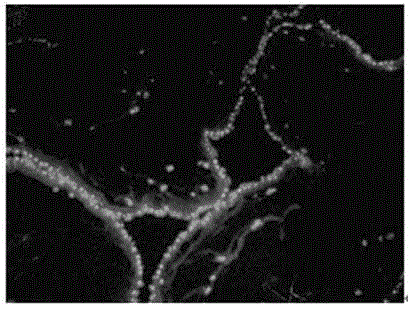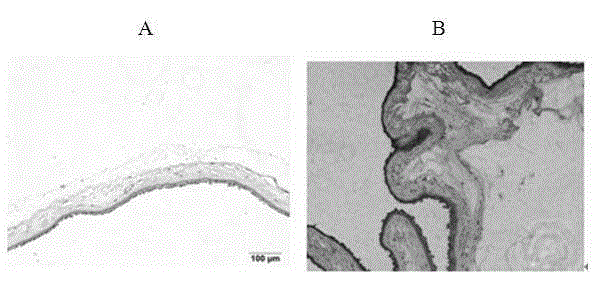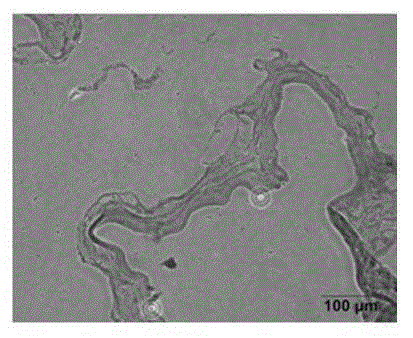Subtotipotent stem cells of human placenta and method for constructing stem cell bank thereof
A technology of subpluripotent stem cells and human placenta, which is applied in the field of inducing differentiation, subpluripotent stem cells, and the preparation of such subpluripotent stem cells, which can solve the problem that cells cannot meet the requirements of storing cell resources, mesenchymal cells contaminate epithelial cells, and epithelial cells grow. Inhibition and other problems, to achieve the effect of easy acquisition, low cost, and simple cell acquisition
- Summary
- Abstract
- Description
- Claims
- Application Information
AI Technical Summary
Problems solved by technology
Method used
Image
Examples
Embodiment 1
[0060] Example 1 Collection of placenta
[0061] ABO / Rh blood type testing, HLA (Human Leukocyte Antigen, human leukocyte antigen) typing testing, microbial immune testing, physical examination HIV (Human Immunodeficiency Virus, human immunodeficiency virus), HBV (Hepatitis B virus for short, B Hepatitis virus), HCV (Hepatitis C virus, hepatitis C virus); and then collect the placenta of the parturient in the operating room.
[0062] Before the placenta is collected, the puerpera fills in the informed consent form and personal basic information, and then the puerpera is identified. The collection process should strictly prevent the contamination of pathogenic microorganisms, and it is required to be carried out in a sterile place, and then the collected placenta is transported to the designated place. The temperature of the transportation environment should be within the range of 4-8oC; when the placenta is received, the receiving form should be filled out, and the placenta bo...
Embodiment 2
[0063] Example 2 Acquisition and isolation of human placental subtotipotent stem cells
[0064] The amniotic membrane was stripped from the placenta, washed repeatedly with D-Hank’s balanced salt solution with a pH value of 7.2-7.4 to remove residual blood, and the amniotic membrane was cut into pieces of 5×5 cm 2 small pieces. One of the amniotic membranes was taken to make a paraffin section and subjected to immunofluorescent staining (SSEA-4, see figure 1 ). figure 1 The results showed that SSEA-4 positive cells were mainly distributed in the outermost layer of the amniotic membrane, that is, the amniotic epithelial layer.
[0065] The amniotic membrane fragments were evenly divided into two groups, A and B, wherein group A was separated by the method described in the present invention, and group B was digested and separated by conventional methods (without separating the epithelial layer from the mesenchymal layer) as a comparison.
[0066] Drop 1mL of D-Hank's balanced...
Embodiment 3
[0076] Example 3 Culture of placental subtotipotent stem cells
[0077] Divide the obtained stem cells into 2×10 5 / cm 2 Inoculate in a culture bottle, add 10mL stem cell culture medium, place at 37oC, CO 2 Cultivate in an incubator with a content of 5%, replace the new stem cell culture medium after 4-5 days, discard the non-adherent cells, and replace the stem cell culture medium every 3-4 days thereafter, until the cells grow to 80% confluent, in the culture Add protease II solution to the bottle for digestion; put the culture bottle in a 37°C incubator for 5 minutes, observe the cells under an inverted microscope, and gently pat the culture bottle with the palm of your hand to ensure that the cells and tissue pieces are completely digested. Add 10mL of stem cell culture medium to the medium, blow and beat repeatedly to clean the cells in the culture flask, transfer the washed cell suspension into a 50mL centrifuge tube, and centrifuge at 1500 rpm for 5 minutes. After the...
PUM
 Login to View More
Login to View More Abstract
Description
Claims
Application Information
 Login to View More
Login to View More - R&D
- Intellectual Property
- Life Sciences
- Materials
- Tech Scout
- Unparalleled Data Quality
- Higher Quality Content
- 60% Fewer Hallucinations
Browse by: Latest US Patents, China's latest patents, Technical Efficacy Thesaurus, Application Domain, Technology Topic, Popular Technical Reports.
© 2025 PatSnap. All rights reserved.Legal|Privacy policy|Modern Slavery Act Transparency Statement|Sitemap|About US| Contact US: help@patsnap.com



